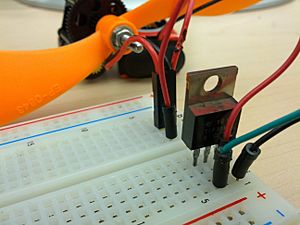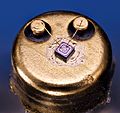Bipolar junction transistor facts for kids
A bipolar junction transistor (often called a BJT or just a bipolar transistor) is a special electronic part that helps control how electricity flows. Think of it like a tiny, super-fast switch or a small amplifier. It's made from two different types of materials called semiconductors that touch each other. BJTs are used in many electronic devices, from simple radios to complex computers. You can find them as individual parts or as tiny pieces inside larger integrated circuits (which are like tiny electronic cities on a chip).
These transistors are called bipolar because they use two kinds of tiny electric particles to work: electrons and "holes." Electrons are negatively charged, and holes are like empty spaces where electrons should be, acting as if they are positively charged. Both of these help carry the electric current through the transistor.
What is a Transistor?
A transistor is a fundamental building block of modern electronics. It's a tiny device that can do two main things:
- Switching: It can turn an electric current on or off, just like a light switch. This is how computers use transistors to process information (0s and 1s).
- Amplifying: It can take a small electrical signal and make it much stronger. This is useful in things like radios, where a tiny signal from an antenna needs to be boosted to make sound.
How BJTs Work Simply
BJTs work by using a small electric current to control a much larger current. Imagine a faucet: a small turn of the handle (the control current) can let a lot of water flow (the larger current).
- BJTs have three main parts, or "legs," called the base, collector, and emitter.
- A tiny current flowing into the base acts like the "control."
- This small control current then allows a much larger current to flow between the collector and the emitter.
- The amount a BJT can boost a signal is called its "current gain." This number is usually quite high, meaning a very small input can lead to a big output.
Where Are BJTs Used?
BJTs are incredibly versatile and are found in countless electronic devices.
- Amplifiers: They make signals stronger in radios, televisions, and audio systems.
- Switches: They turn circuits on and off very quickly in computers, digital clocks, and control systems.
- Oscillators: They can create repeating electronic signals, which are used in things like clock circuits for computers or in radio transmitters.
- Integrated Circuits: Millions or even billions of tiny BJTs can be packed onto a single silicon chip to create microprocessors, memory chips, and other complex electronic brains.
Even though newer types of transistors exist, BJTs are still very important and widely used because they are reliable and work well in many different situations.
Images for kids
See also
 In Spanish: Transistor de unión bipolar para niños
In Spanish: Transistor de unión bipolar para niños



